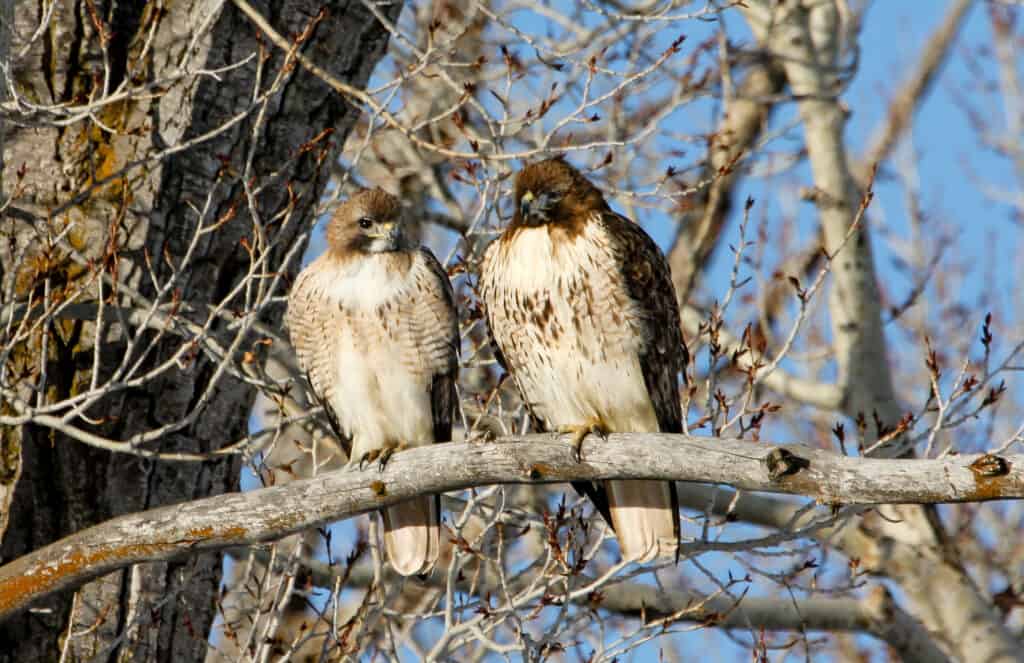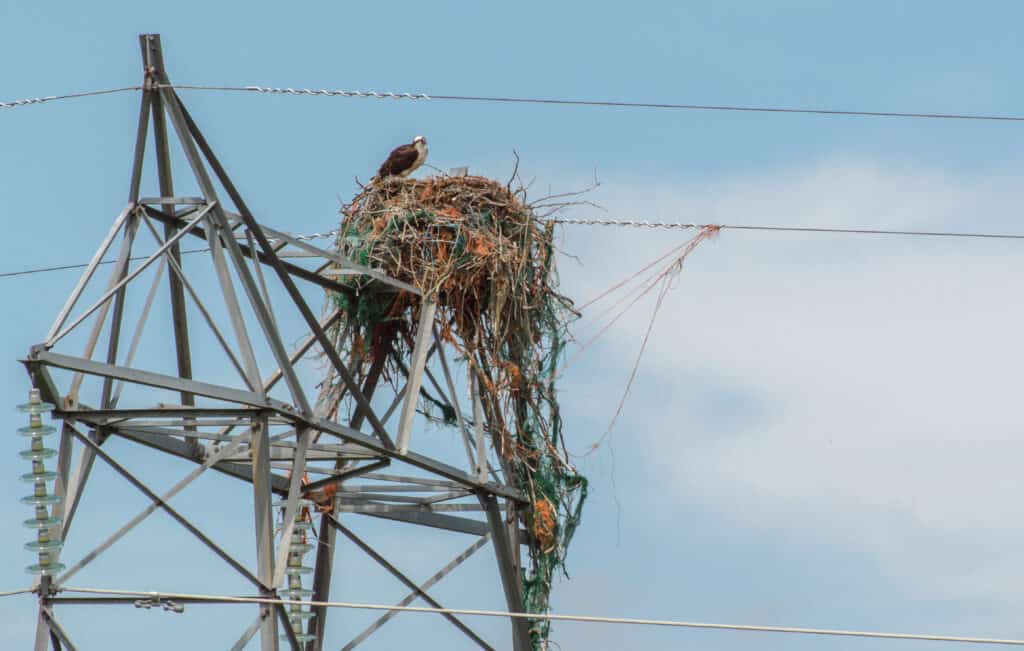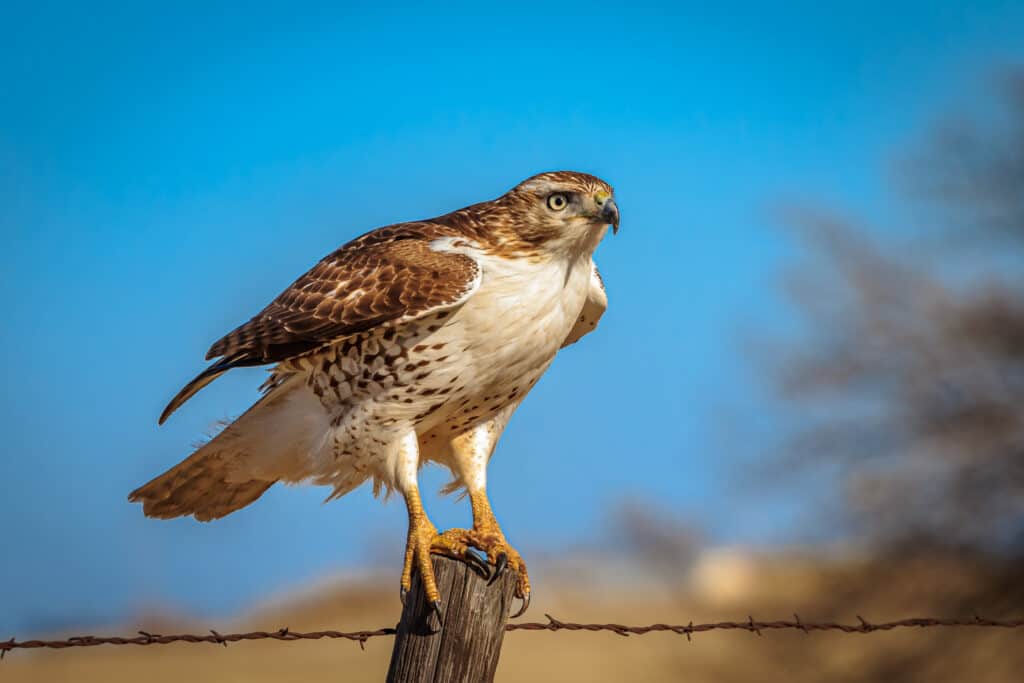Besides being some of the most ferocious predators in the animal kingdom, hawks are also highly territorial when it comes to their nests. They construct these eyries carefully, often taking many days to do so. But not all hawks are alike – different species prefer to nest in different locations and at different heights. So where do hawks nest when preparing for young? Read on to find out!

There are approximately 270 species of hawks in the world.
©J. S. Fisher/Shutterstock.com
Species of Hawks
There are approximately 270 species of hawks within the family Accipitridae. These include the “true hawks” within the subfamily Accipitrinae and the buzzards within the genus Buteo. These two groups are known as accipiter (accipitrine) and buteo (buteonine) hawks.
Accipitrine Hawks
Hawks within the subfamily Accipitrinae are known as “true hawks.” They are typically smaller than buteo hawks with sharp beaks and talons. This subfamily includes the following genera:
- Accipiter
- Microspizias
- Erythrotriorchis
- Megatriorchis
Common species within this subfamily include the following:
- African goshawk (Accipiter tachiro)
- Grey goshawk (Accipiter novaehollandiae)
- Imitator sparrowhawk (Accipiter imitator)
- Pied goshawk (Accipiter albogularis)
- Red goshawk (Erythrotriorchis radiatus)
- Doria’s goshawk (Megatriorchis doriae)
- Tiny hawk (Microspizias superciliosus)
Buteonine Hawks
The Old World designation for members of this genus is “buzzard.” However, the New World recognizes them as hawks. They are usually larger than accipitrine hawks with similar beaks and talons. Common species within this genus include the following:
- Common buzzard (Buteo buteo)
- Red-tailed hawk (Buteo jamaicensis)
- Red-shouldered hawk (Buteo lineatus)
- Broad-winged hawk (Buteo platypterus)
- Short-tailed hawk (Buteo brachyurus)
- Gray hawk (Buteo plagiatus)
- Rugous-tailed hawk (Buteo ventralis)
Where Do Hawks Nest?

Most species of hawks build their nests in tall trees.
©Ronnie Howard/Shutterstock.com
Because hawks occur in almost every region of the world, available habitats vary widely. Local vegetation, geography, and predators all influence where a hawk chooses to build its nest. It also depends on the habits of the individual species.
Hawks construct their nests (eyries) out of various combinations of sticks, bark, dry vegetation, and fresh foliage. Nests can take several days to build with one or both members of a breeding pair carrying materials back to the nesting site. Some nests are as large as 6.5 feet high and three feet wide.
Alternatively, some hawks will return to an old nest instead of building a new one. Some will even take over the nest of a different species. Once the nest is ready, the breeding pair is typically highly territorial.
Trees
There is considerable variation in the types and heights of trees that hawks choose for their nests. Species like the red-tailed hawk typically build their nests near the tops of tall trees as high as 120 feet off the ground. Interestingly, the red-tailed hawk also builds eyries on cliff ledges. Another species, Cooper’s hawk, prefers to build its nests in trees like conifers, white pines, American beeches, and oaks. Another example is the red goshawk, which constructs its nests in the exposed forks of tall trees. Yet another species, the common buzzard, tends to build its nests in trees anywhere from 10-80 feet off the ground.
Just a few examples of hawks that nest in trees are:
- African goshawk
- Common buzzard
- Cooper’s hawk
- Ferruginous hawk
- Grey goshawk
- Red-tailed hawk
- Sharp-shinned hawk
- Tiny hawk
Cliffs
In addition to hawks that nest in trees, some species prefer to build their eyries on cliff ledges. These eyries perch potentially hundreds of feet in the air. The inaccessible location gives the hawks added protection from many predators, including humans. Hawks construct cliff eyries out of materials similar to tree nests.
A couple of examples of hawks that nest on cliffs are:
- Red-tailed hawk
- Rough-legged hawk
- Ferruginous Hawk
The Ground
It is rare for hawk species to build their nests on the ground. However, there are a few that have been known to do so. One of these species is the marsh hawk, a type of harrier within the family Accipitridae. It chooses a mound of dirt or vegetation and constructs a nest of sticks. It then lines the inside of the nest with grass and leaves.
A couple of examples of ground-dwelling hawks are:
- Marsh hawk
- Ferruginous Hawk
Manmade Structures

Some hawks choose to build their nests on manmade structures like power lines.
©Randy Blackwell/Shutterstock.com
Instead of picking a natural object like a tree, some hawks may choose to nest on or within manmade structures. These include power lines, window ledges, and building eaves.
When Are Hawks Most Active?
Hawks are diurnal birds, meaning they are most active during the day. Some species, like the red-tailed hawk, hunt close to dusk, giving the mistaken impression that they hunt at night. However, after the sun goes down, hawks return to their nests for the night.
In terms of seasons, most hawks are particularly active in spring. This is when they choose mates, breed, and build nests in preparation for young. Although they are busy participating in aerial courtship displays and ferrying nest materials to their chosen site, they can be difficult to spot. This is especially true during the secretive process of nest-building. If the breeding pair feels disturbed, they may choose to abandon the nest and start over in a different location.
States With the Most Hawks

There are close to 20 species of hawks in the United States.
©Richard G Smith/Shutterstock.com
There are close to 20 species of hawks in the United States. Given how widespread hawks are, and the fact that many of them are migratory, it can be difficult to know for sure how many hawks actually reside in a state. That said, below are a few of the states with a large estimated number of hawk species:
- Arizona: An estimated 15 species
- Texas: An estimated 15 species
- California: An estimated 13 species
- Colorado: An estimated 13 species
- Louisiana: An estimated 11 species
- Arkansas: An estimated 10 species
- Montana: An estimated 10 species
Conclusion
The place a hawk chooses to build its nest varies widely according to species, region, and available habitat. Most hawks choose to nest in trees, on cliff ledges, on the ground, or even on manmade structures. It is best not to disturb a hawk’s nest as it may drive it away.
The photo featured at the top of this post is © Brenda Carson/Shutterstock.com
Thank you for reading! Have some feedback for us? Contact the AZ Animals editorial team.






